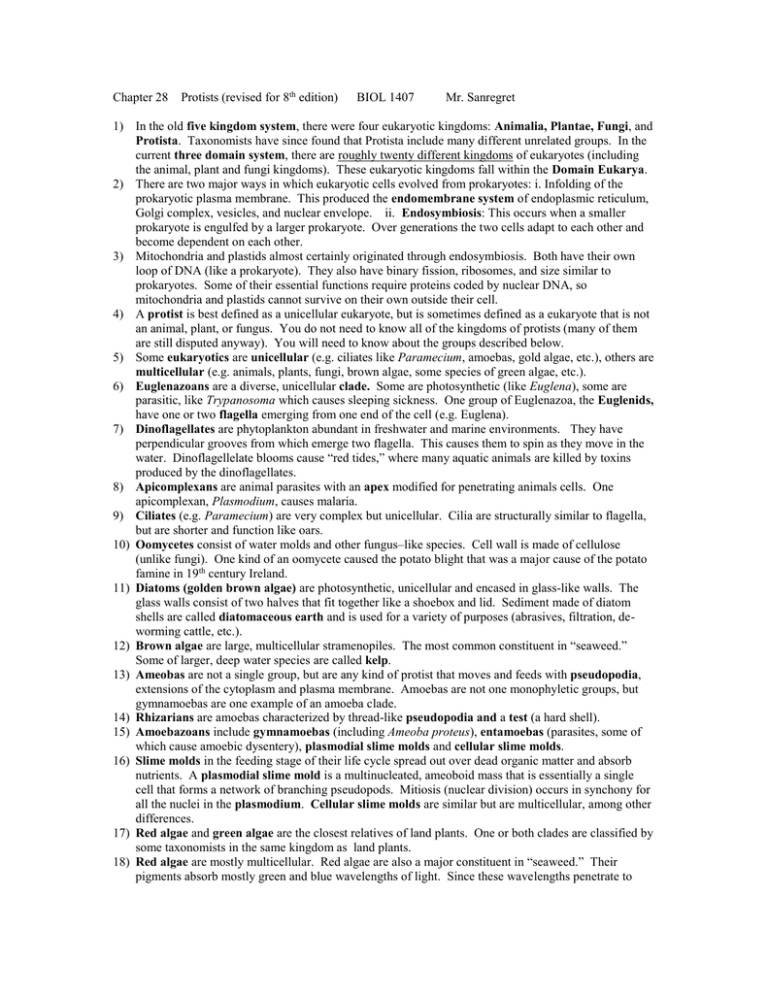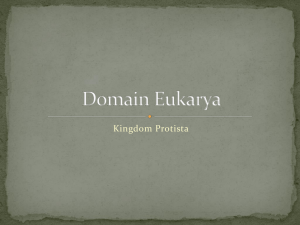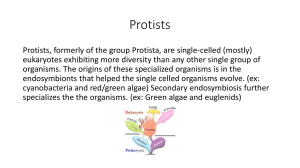lecture notes ch28eukaryotes revised fall 2009.doc
advertisement

Chapter 28 Protists (revised for 8th edition) BIOL 1407 Mr. Sanregret 1) In the old five kingdom system, there were four eukaryotic kingdoms: Animalia, Plantae, Fungi, and Protista. Taxonomists have since found that Protista include many different unrelated groups. In the current three domain system, there are roughly twenty different kingdoms of eukaryotes (including the animal, plant and fungi kingdoms). These eukaryotic kingdoms fall within the Domain Eukarya. 2) There are two major ways in which eukaryotic cells evolved from prokaryotes: i. Infolding of the prokaryotic plasma membrane. This produced the endomembrane system of endoplasmic reticulum, Golgi complex, vesicles, and nuclear envelope. ii. Endosymbiosis: This occurs when a smaller prokaryote is engulfed by a larger prokaryote. Over generations the two cells adapt to each other and become dependent on each other. 3) Mitochondria and plastids almost certainly originated through endosymbiosis. Both have their own loop of DNA (like a prokaryote). They also have binary fission, ribosomes, and size similar to prokaryotes. Some of their essential functions require proteins coded by nuclear DNA, so mitochondria and plastids cannot survive on their own outside their cell. 4) A protist is best defined as a unicellular eukaryote, but is sometimes defined as a eukaryote that is not an animal, plant, or fungus. You do not need to know all of the kingdoms of protists (many of them are still disputed anyway). You will need to know about the groups described below. 5) Some eukaryotics are unicellular (e.g. ciliates like Paramecium, amoebas, gold algae, etc.), others are multicellular (e.g. animals, plants, fungi, brown algae, some species of green algae, etc.). 6) Euglenazoans are a diverse, unicellular clade. Some are photosynthetic (like Euglena), some are parasitic, like Trypanosoma which causes sleeping sickness. One group of Euglenazoa, the Euglenids, have one or two flagella emerging from one end of the cell (e.g. Euglena). 7) Dinoflagellates are phytoplankton abundant in freshwater and marine environments. They have perpendicular grooves from which emerge two flagella. This causes them to spin as they move in the water. Dinoflagellelate blooms cause “red tides,” where many aquatic animals are killed by toxins produced by the dinoflagellates. 8) Apicomplexans are animal parasites with an apex modified for penetrating animals cells. One apicomplexan, Plasmodium, causes malaria. 9) Ciliates (e.g. Paramecium) are very complex but unicellular. Cilia are structurally similar to flagella, but are shorter and function like oars. 10) Oomycetes consist of water molds and other fungus–like species. Cell wall is made of cellulose (unlike fungi). One kind of an oomycete caused the potato blight that was a major cause of the potato famine in 19th century Ireland. 11) Diatoms (golden brown algae) are photosynthetic, unicellular and encased in glass-like walls. The glass walls consist of two halves that fit together like a shoebox and lid. Sediment made of diatom shells are called diatomaceous earth and is used for a variety of purposes (abrasives, filtration, deworming cattle, etc.). 12) Brown algae are large, multicellular stramenopiles. The most common constituent in “seaweed.” Some of larger, deep water species are called kelp. 13) Ameobas are not a single group, but are any kind of protist that moves and feeds with pseudopodia, extensions of the cytoplasm and plasma membrane. Amoebas are not one monophyletic groups, but gymnamoebas are one example of an amoeba clade. 14) Rhizarians are amoebas characterized by thread-like pseudopodia and a test (a hard shell). 15) Amoebazoans include gymnamoebas (including Ameoba proteus), entamoebas (parasites, some of which cause amoebic dysentery), plasmodial slime molds and cellular slime molds. 16) Slime molds in the feeding stage of their life cycle spread out over dead organic matter and absorb nutrients. A plasmodial slime mold is a multinucleated, ameoboid mass that is essentially a single cell that forms a network of branching pseudopods. Mitiosis (nuclear division) occurs in synchony for all the nuclei in the plasmodium. Cellular slime molds are similar but are multicellular, among other differences. 17) Red algae and green algae are the closest relatives of land plants. One or both clades are classified by some taxonomists in the same kingdom as land plants. 18) Red algae are mostly multicellular. Red algae are also a major constituent in “seaweed.” Their pigments absorb mostly green and blue wavelengths of light. Since these wavelengths penetrate to lower depths of water than other wavelengths, red algae can be found at lower depths than other kinds of algae. 19) Green algae have chloroplasts with chlorophyll which give them their green color, similar to plants. Green algae and plants share a recent common ancestor, and it is possible that in future taxonomic systems, green algae and plants may be classified together in the same kingdom. Euglenazoans dinoflagellates apicomplexans Ciliates Oomycetes Diatoms Brown algae Rhizarians Amoebazoans Animals Fungi Red algae Green algae Plants Trypanosoma (caused sleeping sickness) and euglena perpendicular grooves from which emerge two flagella Parasitic; apex modified for penetrating animals cells Ciliated, Very complex cells, includes Paramecium water molds and other fungus–like species, cellulose cell wall photosynthetic, unicellular and encased in two glass-like walls large, multicellular “seaweed”; includes kelp and sargassum shelled amoebas with threadlike pseudopodia Gymnamoebas, entamoebas, cellular slime molds, plasmodial slime molds Covered in later chapters Covered in later chapter Close relative of green algae and plants, have different photosynthetic pigments have chloroplasts with chlorophyll which give them their green color Covered in later chapters






